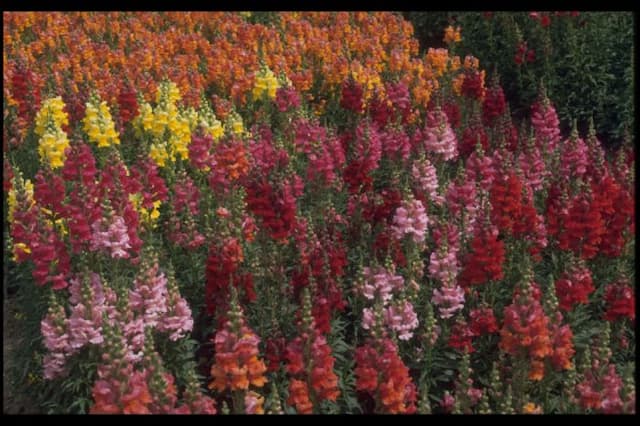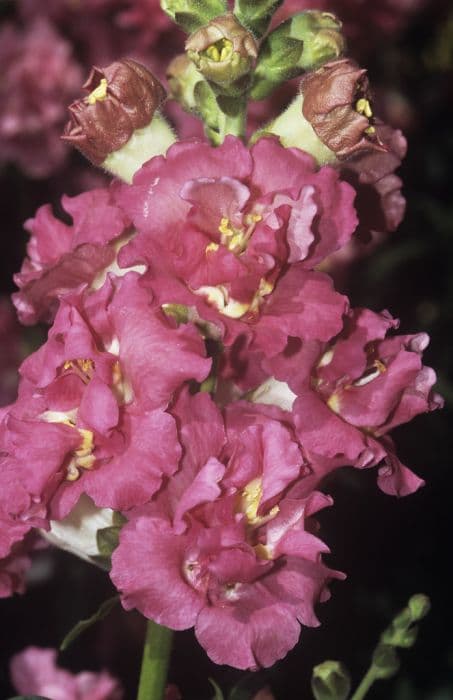Penstemon 'Melting Candy' Penstemon 'Melting Candy' (Ice Cream Series)

ABOUT
'Melting Candy' (Ice Cream Series) is a bushy, semi-evergreen perennial to 80cm tall, with slender mid-green leaves and from summer to autumn, large, bright-pink tubular flowers with a white throat
About this plant
 Names
NamesFamily
Plantaginaceae
Synonyms
Beardtongue, Beard Tongue
Common names
Penstemon 'Melting Candy'.
 Characteristics
CharacteristicsLife cycle
Perennials
Foliage type
Deciduous
Color of leaves
Green
Flower color
Pink
Height
2 feet (60 cm)
Spread
2 feet (60 cm)
Plant type
Herb
Hardiness zones
4
Native area
North America
Benefits
 General Benefits
General Benefits- Attracts pollinators: This variety is particularly attractive to bees and butterflies, contributing to the health of the local ecosystem.
- Ease of care: Penstemon 'Melting Candy' is known for being low maintenance, requiring minimal watering and care once established.
- Drought tolerance: It is well suited for xeriscaping or gardens in arid climates due to its ability to withstand periods of low water availability.
- Colorful blooms: The plant produces vibrantly colored flowers that add aesthetic appeal to any garden space.
- Long flowering period: It has a prolonged blooming season, often from late spring to early fall, providing long-lasting garden interest.
- Cold hardiness: This cultivar can survive in cooler temperatures, making it suitable for a variety of climates.
- Deer resistance: Penstemon 'Melting Candy' is less likely to be eaten by deer, which can be beneficial in areas where deer browsing is a problem.
- Versatility in landscaping: It can be used in a multitude of gardening designs, including borders, rock gardens, and wildflower meadows.
 Medical Properties
Medical PropertiesThis plant is not used for medical purposes.
 Air-purifying Qualities
Air-purifying QualitiesThis plant is not specifically known for air purifying qualities.
 Other Uses
Other Uses- Butterfly Gardening: Penstemons, including the 'Melting Candy' variant, are known to attract butterflies, making them a valuable plant for creating a butterfly garden.
- Photography Subject: The 'Melting Candy' Penstemon, with its vibrant colors, can be a captivating subject for garden photographers.
- Edible Flowers: Although not widely known for its edibility, some Penstemons have edible flowers that can be used as a garnish or in salads for a mild flavor.
- Educational Tool: The variation in Penstemon species, including 'Melting Candy', can be used to teach botany and plant hybridization techniques in educational settings.
- Art Inspiration: Artists may use the bright flowers of 'Melting Candy' Penstemons as inspiration for paintings, drawings, or textile designs.
- Culinary Decoration: The colorful blooms can embellish cakes or desserts as a non-toxic decorative element.
- Fragrance Garden Component: While not all Penstemons are fragrant, incorporating 'Melting Candy' in a fragrance garden can contribute to the overall sensory experience with its subtle aroma.
- Sand Erosion Control: The root system of Penstemons can help stabilize sandy soils and prevent erosion in certain landscaped areas.
- Drought Education: Due to its drought tolerance, 'Melting Candy' Penstemon can be utilized in educational gardens that demonstrate water-wise gardening practices.
- Craft Projects: Dried 'Melting Candy' Penstemon flowers can be used in various craft projects, such as in homemade potpourri mixes or floral arrangements.
Interesting Facts
 Feng Shui
Feng ShuiThe Beardtongue is not used in Feng Shui practice.
 Zodiac Sign Compitability
Zodiac Sign CompitabilityThe Beardtongue is not used in astrology practice.
 Plant Symbolism
Plant Symbolism- Attraction: With its candy-like colors and charming blooms, the Penstemon often symbolizes attraction and allure, reflecting its ability to draw in both pollinators and human admirers.
- Health and Vitality: Known for its hardiness and longevity in the garden, Penstemon may also represent good health and vitality.
- Diversity: As a member of a genus with a wide range of species and hybrids, the Penstemon can signify diversity and variety in life.
 Water
WaterFor Beardtongue, also known as Penstemon, water the plant deeply once a week, providing about one inch of water or approximately 0.6 gallons per square foot per watering session. During hot or dry spells, increase watering to twice a week. Always check the soil before watering; it should be moist but not waterlogged. Reduce watering in the winter when the plant is dormant.
 Light
LightBeardtongue thrives in full sun to partial shade. The ideal spot for this plant is an area where it can receive at least six hours of direct sunlight daily. However, in extremely hot climates, some afternoon shade is beneficial to prevent scorching.
 Temperature
TemperatureBeardtongue prefers temperatures between 50°F and 85°F but can withstand temperatures as low as 20°F. It is tolerant of a wide range of conditions but performs best in moderately warm climates. Frost can damage the plant, so provide protection if temperatures are expected to dip below the minimum threshold.
 Pruning
PruningPrune Beardtongue to promote bushier growth and more flowers. Remove spent flower stalks after blooming to encourage a second flush of flowers. Pruning is best done in early spring before new growth starts or immediately after the first flowering period.
 Cleaning
CleaningAs needed
 Soil
SoilBeardtongue prefers well-draining soil with a slightly acidic to neutral pH between 6.0 and 7.0. A mixture of loamy or sandy soil amended with organic matter such as compost or peat moss can create an ideal environment. Ensure good drainage to prevent root rot.
 Repotting
RepottingBeardtongue plants typically do not need frequent repotting and can be repotted every 2-3 years or when they outgrow their current container. Check for overcrowding in spring and repot if necessary.
 Humidity & Misting
Humidity & MistingBeardtongue plants are adaptable and do not require high humidity levels. They thrive in average humidity conditions typical of outdoor environments and can tolerate some dry air. No specific humidity level is necessary.
 Suitable locations
Suitable locationsIndoor
Ensure bright indirect light and avoid overwatering.
Outdoor
Full sun to partial shade and well-draining soil.
Hardiness zone
4-9 USDA
 Life cycle
Life cycleThe life of the Penstemon 'Melting Candy' (Beardtongue) begins with seed germination, which typically occurs in warm, moist soil conditions. After germination, it enters a vegetative stage where it develops a rosette of leaves at the soil level. As it matures, it develops a sturdy stem and produces a profusion of tubular flowers that are attractive to pollinators like hummingbirds and bees. Following pollination, the flowers develop into seed capsules which eventually dry and release seeds for the next generation. In climates with cold winters, the Penstemon 'Melting Candy' may die back to the ground, with its roots surviving to regrow the next spring. Over time, the plant can become woody at the base, and it may require division or replacement after several years to maintain vigor.
 Propogation
PropogationPropogation time
Spring-Early Summer
The Penstemon 'Melting Candy', also known by its common name Beardtongue, is best propagated by taking stem cuttings. This is typically done in late spring or early summer when the plant is actively growing. Cuttings should be about 3 to 4 inches (about 7.6 to 10.2 centimeters) long and taken with a clean, sharp pair of scissors or pruners. Remove the lower leaves and dip the cut end into a rooting hormone to increase the chance of success. Then, plant the stem cuttings in a well-draining soil mix, keeping them moist and covered with a plastic bag to maintain humidity. Roots usually develop within a few weeks, after which you can gradually acclimate the young plants to less humid conditions before planting them out.





![Snapdragon [Pretty in Pink]](/_next/image?url=https%3A%2F%2Fplants-admin.emdemapps.com%2Fimages%2Fplants%2F%2Fimages%2F604b5cb3b5385.png&w=640&q=75)



